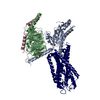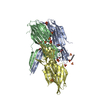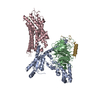[English] 日本語
 Yorodumi
Yorodumi- SASDFD6: Protein kinase YopO - cytoplasmic 1 actin complex (Protein kinase... -
+ Open data
Open data
- Basic information
Basic information
| Entry | Database: SASBDB / ID: SASDFD6 |
|---|---|
 Sample Sample | Protein kinase YopO - cytoplasmic 1 actin complex
|
| Function / homology |  Function and homology information Function and homology informationpositive regulation of norepinephrine uptake / bBAF complex / cellular response to cytochalasin B / npBAF complex / nBAF complex / brahma complex / regulation of transepithelial transport / Formation of annular gap junctions / Formation of the dystrophin-glycoprotein complex (DGC) / morphogenesis of a polarized epithelium ...positive regulation of norepinephrine uptake / bBAF complex / cellular response to cytochalasin B / npBAF complex / nBAF complex / brahma complex / regulation of transepithelial transport / Formation of annular gap junctions / Formation of the dystrophin-glycoprotein complex (DGC) / morphogenesis of a polarized epithelium / structural constituent of postsynaptic actin cytoskeleton / Gap junction degradation / GBAF complex / Folding of actin by CCT/TriC / regulation of G0 to G1 transition / protein localization to adherens junction / Cell-extracellular matrix interactions / dense body / Tat protein binding / postsynaptic actin cytoskeleton / Prefoldin mediated transfer of substrate to CCT/TriC / RSC-type complex / regulation of double-strand break repair / regulation of nucleotide-excision repair / Adherens junctions interactions / RHOF GTPase cycle / adherens junction assembly / apical protein localization / Sensory processing of sound by outer hair cells of the cochlea / Interaction between L1 and Ankyrins / tight junction / SWI/SNF complex / regulation of mitotic metaphase/anaphase transition / Sensory processing of sound by inner hair cells of the cochlea / positive regulation of T cell differentiation / apical junction complex / positive regulation of double-strand break repair / maintenance of blood-brain barrier / regulation of norepinephrine uptake / nitric-oxide synthase binding / transporter regulator activity / cortical cytoskeleton / establishment or maintenance of cell polarity / NuA4 histone acetyltransferase complex / positive regulation of stem cell population maintenance / Recycling pathway of L1 / Regulation of MITF-M-dependent genes involved in pigmentation / brush border / regulation of G1/S transition of mitotic cell cycle / EPH-ephrin mediated repulsion of cells / negative regulation of cell differentiation / kinesin binding / RHO GTPases Activate WASPs and WAVEs / regulation of synaptic vesicle endocytosis / positive regulation of myoblast differentiation / RHO GTPases activate IQGAPs / regulation of protein localization to plasma membrane / positive regulation of double-strand break repair via homologous recombination / EPHB-mediated forward signaling / cytoskeleton organization / substantia nigra development / axonogenesis / calyx of Held / nitric-oxide synthase regulator activity / FCGR3A-mediated phagocytosis / actin filament / adherens junction / Translocation of SLC2A4 (GLUT4) to the plasma membrane / Regulation of endogenous retroelements by Piwi-interacting RNAs (piRNAs) / positive regulation of cell differentiation / cell motility / RHO GTPases Activate Formins / Signaling by high-kinase activity BRAF mutants / MAP2K and MAPK activation / DNA Damage Recognition in GG-NER / Regulation of actin dynamics for phagocytic cup formation / B-WICH complex positively regulates rRNA expression / kinetochore / structural constituent of cytoskeleton / Hydrolases; Acting on acid anhydrides; Acting on acid anhydrides to facilitate cellular and subcellular movement / VEGFA-VEGFR2 Pathway / platelet aggregation / Schaffer collateral - CA1 synapse / tau protein binding / nuclear matrix / cytoplasmic ribonucleoprotein granule / Signaling by RAF1 mutants / Signaling by moderate kinase activity BRAF mutants / Paradoxical activation of RAF signaling by kinase inactive BRAF / Signaling downstream of RAS mutants / cell-cell junction / Signaling by BRAF and RAF1 fusions / UCH proteinases / nucleosome / presynapse / lamellipodium / actin cytoskeleton / Clathrin-mediated endocytosis / HATs acetylate histones / Factors involved in megakaryocyte development and platelet production Similarity search - Function |
| Biological species |  Yersinia enterocolitica (bacteria) Yersinia enterocolitica (bacteria) Homo sapiens (human) Homo sapiens (human) |
 Citation Citation |  Journal: Structure / Year: 2019 Journal: Structure / Year: 2019Title: Studying Conformational Changes of the Yersinia Type-III-Secretion Effector YopO in Solution by Integrative Structural Biology. Authors: Martin F Peter / Anne T Tuukkanen / Caspar A Heubach / Alexander Selsam / Fraser G Duthie / Dmitri I Svergun / Olav Schiemann / Gregor Hagelueken /  Abstract: The type-III secretion effector YopO helps pathogenic Yersinia to outmaneuver the human immune system. Injected into host cells, it functions as a Ser/Thr kinase after activation by actin binding. ...The type-III secretion effector YopO helps pathogenic Yersinia to outmaneuver the human immune system. Injected into host cells, it functions as a Ser/Thr kinase after activation by actin binding. This activation process is thought to involve large conformational changes. We use PELDOR spectroscopy and small-angle X-ray scattering in combination with available crystal structures to study these conformational transitions. Low-resolution hybrid models of the YopO/actin structure in solution were constructed, where the kinase domain of YopO is tilted "backward" compared with the crystal structure, thus shortening the distance between actin and the kinase active site, potentially affecting the substrate specificity of YopO. Furthermore, the GDI domain of the hybrid models resembles a conformation that was previously observed in a crystal structure of the isolated GDI domain. We investigate possible structural reasons for the inactivity of the apo state, analyze its flexibility and discuss the biological implications. |
 Contact author Contact author |
|
- Structure visualization
Structure visualization
| Structure viewer | Molecule:  Molmil Molmil Jmol/JSmol Jmol/JSmol |
|---|
- Downloads & links
Downloads & links
-Data source
| SASBDB page |  SASDFD6 SASDFD6 |
|---|
-Related structure data
| Related structure data | C: citing same article ( |
|---|---|
| Similar structure data |
- External links
External links
| Related items in Molecule of the Month |
|---|
-Models
| Model #2981 |  Type: atomic / Comment: PELDOR/SAXS refinement without clash penalty / Chi-square value: 1.098 / P-value: 0.013370  Search similar-shape structures of this assembly by Omokage search (details) Search similar-shape structures of this assembly by Omokage search (details) |
|---|---|
| Model #2980 |  Type: atomic / Comment: PELDOR/SAXS refinement with clash penalty / Chi-square value: 1.123 / P-value: 0.003355  Search similar-shape structures of this assembly by Omokage search (details) Search similar-shape structures of this assembly by Omokage search (details) |
| Model #2982 |  Type: atomic Comment: Model ignoring the Kinase 113 – Actin 374 restraint Chi-square value: 1.075 / P-value: 0.013370  Search similar-shape structures of this assembly by Omokage search (details) Search similar-shape structures of this assembly by Omokage search (details) |
- Sample
Sample
 Sample Sample | Name: Protein kinase YopO - cytoplasmic 1 actin complex / Specimen concentration: 5.52 mg/ml / Entity id: 1636 / 1637 |
|---|---|
| Buffer | Name: 10 mM Tris-HCl, 50 mM NaCl / pH: 8 |
| Entity #1636 | Name: YopO / Type: protein / Description: Protein kinase YopO / Formula weight: 63.387 / Num. of mol.: 1 / Source: Yersinia enterocolitica / References: UniProt: Q93KQ6 Sequence: KPQTELPLGW KGKPLSGAPD LEGMRVAHIS IIERLVAKIG HLFAELEAYK HIYKTAGKHP NLANVHGMAV VPYGNRYYYA LLMDEVDGWR CSDTLRSLAD SWKQGKINSE AYWGTIKFIA HRLLDVTNHL AKAGIVHNDI KPGNVVFDRA SGEPVVIDLG LHSRSGEQPK ...Sequence: KPQTELPLGW KGKPLSGAPD LEGMRVAHIS IIERLVAKIG HLFAELEAYK HIYKTAGKHP NLANVHGMAV VPYGNRYYYA LLMDEVDGWR CSDTLRSLAD SWKQGKINSE AYWGTIKFIA HRLLDVTNHL AKAGIVHNDI KPGNVVFDRA SGEPVVIDLG LHSRSGEQPK GFTESFKAPE LGVGGASEKS DVFLVVSTLL HGIEGFEKDP EIKPNQGLRF ITSEPAHVMD ENGYPIHRPG IAGVETAYTR FITDILGVSA DSRPDSNEAR LHEFLSDGTI DEESAKQILK DTLTGEMSIT PYYLRELSDL LRTHLSSAAT KQLDMGVVLS DLDTMLVALD KAEREGGVDK DQLKSFNSLI LKTYSVIGAY ILSIVEPSLQ RIQKHLDQTH SFSDIGSLMR AHKHLETLLE VLVTLSQQGQ PVSSETYSFL NRLAEAKVTL SQQLNTLQQQ QESAKAQLSI LINRSGSWAD VARQSLQRFD STRPVVKFGT EQYTAIHRQM MAAHAAITLQ EVSEFTDDMR NFTADSIPLL IQLGRSSLMD EHLVEQREKL RELTTIAERL NRLEREWM |
| Entity #1637 | Name: Actin / Type: protein / Description: Actin, cytoplasmic 1 / Formula weight: 41.737 / Num. of mol.: 1 / Source: Homo sapiens / References: UniProt: P60709 Sequence: MDDDIAALVV DNGSGMCKAG FAGDDAPRAV FPSIVGRPRH QGVMVGMGQK DSYVGDEAQS KRGILTLKYP IEHGIVTNWD DMEKIWHHTF YNELRVAPEE HPVLLTEAPL NPKANREKMT QIMFETFNTP AMYVAIQAVL SLYASGRTTG IVMDSGDGVT HTVPIYEGYA ...Sequence: MDDDIAALVV DNGSGMCKAG FAGDDAPRAV FPSIVGRPRH QGVMVGMGQK DSYVGDEAQS KRGILTLKYP IEHGIVTNWD DMEKIWHHTF YNELRVAPEE HPVLLTEAPL NPKANREKMT QIMFETFNTP AMYVAIQAVL SLYASGRTTG IVMDSGDGVT HTVPIYEGYA LPHAILRLDL AGRDLTDYLM KILTERGYSF TTTAEREIVR DIKEKLCYVA LDFEQEMATA ASSSSLEKSY ELPDGQVITI GNERFRCPEA LFQPSFLGME SCGIHETTFN SIMKCDVDIR KDLYANTVLS GGTTMYPGIA DRMQKEITAL APSTMKIKII APPERKYSVW IGGSILASLS TFQQMWISKQ EYDESGPSIV HRKCF |
-Experimental information
| Beam | Instrument name: PETRA III EMBL P12 / City: Hamburg / 国: Germany  / Type of source: X-ray synchrotron / Wavelength: 0.124 Å / Dist. spec. to detc.: 3 mm / Type of source: X-ray synchrotron / Wavelength: 0.124 Å / Dist. spec. to detc.: 3 mm | ||||||||||||||||||||||||||||||||||||
|---|---|---|---|---|---|---|---|---|---|---|---|---|---|---|---|---|---|---|---|---|---|---|---|---|---|---|---|---|---|---|---|---|---|---|---|---|---|
| Detector | Name: Pilatus 2M | ||||||||||||||||||||||||||||||||||||
| Scan |
| ||||||||||||||||||||||||||||||||||||
| Distance distribution function P(R) |
| ||||||||||||||||||||||||||||||||||||
| Result |
|
 Movie
Movie Controller
Controller


























